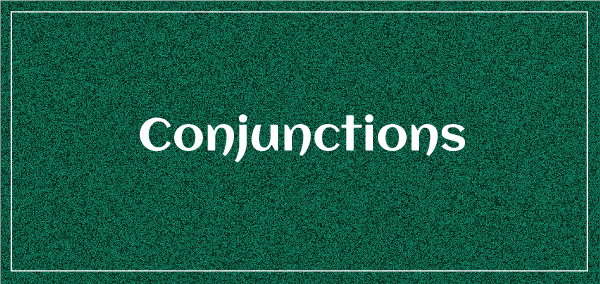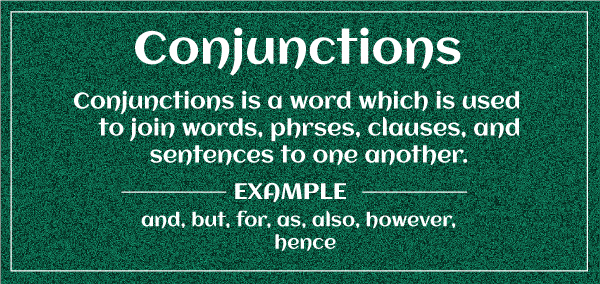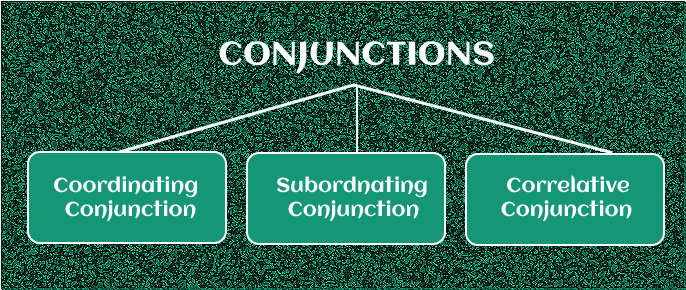ConjunctionThe kids were soundly sleeping. Their grandparents were sleeping. Their dogs were blissfully sleeping. These sentences' function OK on their own, but don't you think they're a touch repetitive? Instead, let's join them with a conjunction. The kids, their parents, and their pets were all fast asleep. 
That looks so much better, doesn't it? Conjunctions are extremely useful words that join components of speech to construct more complicated sentences. Let's find out more about these grammatical companions and how we may use them to create better sentences that we'll like writing. What is a Conjunction?Conjunctions refer to the terms that join together words, phrases, clauses, and sentences. A common example of a conjunction is the term and. Here are two examples of how to utilize the conjunction "and" in both simple and complex sentences: The blossom is red and white in color. (joins two adjectival words) The blossom is red, and it has a distinct odor. (joins two sentences)
There are mainly three kinds of conjunctions: coordinating, subordinating, and correlative, each with its own goal but all acting to connect words. We no longer have to make short, fragmented sentences because of conjunctions. We can make our sentences longer by using simple words like "and" or "but," as well as a comma or two. So, conjunction is not only a joiner, but it's also so much more. 
Conjunctions are terms that join together other words, statements, or clauses. Correct: I enjoy cooking and eating, but I dislike doing the dishes afterward. Correct: Sophie is visibly fatigued, yet she keeps on dancing till the sun comes up. Conjunctions enable you to create rich, graceful sentences while avoiding the choppiness of several short sentences. Check that the sentences connected by conjunctions are similar (share the same structure). Incorrect: I act quickly and meticulous. Correct: I act quickly and meticulously. Coordinating ConjunctionsWhen most individuals hear the term "conjunction," they think of coordinating conjunctions. They link words, sentences, and independent clauses altogether. Short and fragmented sentences can be combined into long lines with them. There are 7 of them, and remembering them is simple if you think of the abbreviation "FANBOYS." For - Explains the reasons or purpose of something (just like "because") And- This term helps in adding one item to another. Nor - Used to provide an alternate negative view to an already stated negative idea. But - Displays a contrast Or - Presents an alternative option/choice Yet - Introduces an opposing idea that logically follows the prior idea. So - Denotes an effect, result, or outcome. Coordinating conjunctions unite words, phrases, and clauses of the same grammatical ranking in a statement. Essentially, coordinating conjunctions are the type of conjunctions that are utilized to link the independent clauses. An independent clause refers to the phrase which can be used as a proper sentence on its own. Sentences with Coordinating ConjunctionsHere are a few sentences that use the coordinating conjunctions:
Conjunctions can also be formed by transitional words such as "however" and "therefore":

Subordinating ConjunctionIndependent as well as dependent clauses can be combined together using the subordinating conjunctions. Subordinating conjunction might indicate a cause-and-effect link, a contrast, or another type of interaction among clauses. Because, since, as, although, though, while, and whereas are common subordinating conjunctions. An adverb, such as until, after, or before, often can work as conjunction. Contrary to an independent clause, a subordinate clause cannot exist independently as a full sentence. As an example: where the bison roam(not a full sentence) On the other hand, subordinating conjunction may be used to connect a subordinate sentence to an independent phrase. Subordinating conjunctions can appear at the start or the middle of a statement:
Correlative ConjunctionsCorrelative conjunctions are conjunction pairs that function in tandem. These conjunctions act in pairs to connect phrases or terms of similar value within a statement. These comprise of terms like both... and, either... or, neither... nor, and rather... than. Each combo or pair of the correlative conjunctions has a distinct purpose. Here are a couple of such examples:
Conjunctive AdverbsWhile some instructors do not teach these vital aspects of speech with conjunctions, they are worth mentioning here. These adverbs are always employed to connect clauses and to demonstrate sequence, contrast, cause and effect, and other interactions. When individuals initially start writing, they usually start with simple statements like, "My name is Teddy. I am a young man. "I adore pups." Conjunctions play a key role in connecting these brief phrases so that they sound more like this: "I am a guy named Teddy, and I adore puppies." The Rules of ConjunctionConjunctions, for the most part, aren't difficult to utilize appropriately. There are, however, some ground rules to follow. Where Should I Position Conjunctions?Conjunctions are regularly used to connect two or more objects. As an example,
Exemptions to this basic guideline are that the subordinating conjunctions can be utilized at the start of a sentence and the initial of a combo/pair of correlative conjunctions:
It is commonly stated that coordinating conjunctions such as and, or, but cannot be used to begin a sentence. However, this "rule" is frequently disregarded, and it is totally permissible to start a phrase with a coordinating conjunction. All you need to do is make sure your statements are clear. As an example:
Additionally, there are a few crucial guidelines to remember while utilizing conjunctions. Remember them, and you'll notice that your writing flows better as a result: 1. Conjunctions are used to connect nouns, sentences, and other speech components and thoughts, actions, and concepts. For instance, Jane went to the grocery store and purchased bananas. 2. Conjunctions can be used to create lists. For example, we made croissants, eggs, and tea for lunch. 3. When employing conjunctions, one needs to make sure that all of the statements' elements agree or sync. For instance: "I act quickly yet am cautious" does not agree. "I act quickly yet cautiously," demonstrates agreement. Proper Comma UsageThe comma is frequently the punctuation mark that creates the most confusion. The following are the general guidelines for using commas with conjunctions: 1. Coordinating Conjunctions: When combining independent sentences or making a list, use a comma before the conjunction. When linking things that aren't separate clauses, never use a comma: Independent clause: I adore my mom, and she loves me. (comma) List: I want to try chocolate, caramel, or blueberry ice cream. (comma) Not an independent clause: That sweatshirt is warm and scratchy. (There is no comma) 2. Subordinating Conjunctions: Until a subordinating phrase is used at the start of a sentence, there is no need for a comma. If it is, a comma should be placed at the conclusion of the whole subordinate clause: There is no comma: I breezed through the exam because I studied so diligently. Comma: Because I studied diligently, I passed with flying colors easily. 3. Correlative Conjunctions: Correlative conjunctions do not usually require a comma. They may exist alongside a comma if the comma is being used for anything else, like dividing out a modifier. As an example, I chatted with both Emma, who had no idea what had transpired and William, who did. Combining Several Sorts of ConjunctionsIt is completely acceptable to utilize all of the various sorts of conjunctions in the same statement. Keep in mind that coordinating conjunctions are utilized to connect independent clauses whereas the subordinating conjunctions are employed to link independent clauses with the subordinate clauses. Sentences might become very long and convoluted at times, but you must understand when and where to employ commas. Here's an example of a complex sentence that makes use of all three sorts of conjunctions. Only the coordinating conjunction, which joins two separate clauses, utilizes a comma: I tried to persuade my mother and father that I was clean, but my plan was foiled because both my brother and sister informed them that I had broken the glass.
Next TopicCoordinating Conjunction
|
 For Videos Join Our Youtube Channel: Join Now
For Videos Join Our Youtube Channel: Join Now
Feedback
- Send your Feedback to [email protected]
Help Others, Please Share









